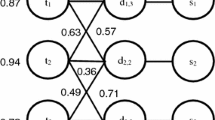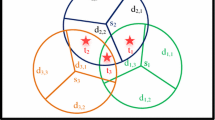Abstract
The extensive applications of directional sensor networks (DSNs) in a wide range of situations have recently attracted a great deal of attention. DSNs primarily operate based on simultaneously observing a group of events (targets) occurring in a set area and maximizing network lifetime, as there are limitations to the directional sensors’ sensing angle and battery power. The higher the number of sensing ranges of the sensors and the more different the coverage requirements for the targets, the more complex this issue will be. Also known as priority-based target coverage with adjustable sensing ranges (PTCASR), this issue, which has not yet been investigated in the field of study, is the highlight of this research. A potential solution to this problem, based on the fact that sensors are frequently densely deployed, would be to organize the sensors into a few cover sets. After that the cover sets needs to be successively activated—this process is referred to as the scheduling technique. This paper aims to resolve the issue of PTCASR with the proposal of two scheduling algorithms i.e. greedy-based and learning automata-based algorithms. These proposed algorithms were assessed for their performance via a number of experiments. Additionally, the effect of each algorithm on maximizing network lifetime was also investigated via a comparative study. Both algorithms were successful in solving the problem; however, the learning automata-based scheduling algorithm proved relatively superior to the greedy-based algorithm when it came to extending network lifetime.







Similar content being viewed by others
References
Ai, J., & Abouzeid, A. (2006). Coverage by directional sensors in randomly deployed wireless sensor networks. Journal of Combinatorial Optimization, 11(1), 21–41.
Amac Guvensan, M., & Gokhan Yavuz, A. (2011). On coverage issues in directional sensor networks: A survey. Ad Hoc Networks, 9(7), 1238–1255.
Cardei, M., Thai, M. T., Yingshu, L., & Weili, W. (2005). Energy-efficient target coverage in wireless sensor networks. In Proceedings of 24th annual joint conference of the IEEE computer and communications societies (INFOCOM) (pp. 1976–1984). Miami, FL, USA.
Cardei, M., Wu, J., Lu, M., & Pervaiz, M. O. (2005). Maximum network lifetime in wireless sensor networks with adjustable sensing ranges. In Proceedings of international conference on wireless and mobile computing, networking and communications (pp. 438–445).
Cardei, M., & Du, D.-Z. (2005). Improving wireless sensor network lifetime through power aware organization. Wireless Networks, 11(3), 333–340.
Cardei, M., Wu, J., & Lu, M. (2006). Improving network lifetime using sensors with adjustable sensing ranges. International Journal of Sensor Networks, 1, 41–49.
Cerulli, R., De Donato, R., & Raiconi, A. (2012). Exact and heuristic methods to maximize network lifetime in wireless sensor networks with adjustable sensing ranges. European Journal of Operational Research, 220, 58–66.
Dhawan, A., Aung, A., & Prasad, S. (2010). Distributed scheduling of a network of adjustable range sensors for coverage problems. Information Systems, Technology and Management, 54, 123–132.
Gil, J.-M., & Han, Y.-H. (2011). A target coverage scheduling scheme based on genetic algorithms in directional sensor networks. Sensors, 11(2), 1888–1906.
Huiqiang, Y., Deying, L., & Hong, C. (2010). Coverage quality based target-oriented scheduling in directional sensor networks. In Proceedings of international conference on communications (pp. 1–5).
Jarray, F. (2013). A lagrangean-based heuristics for the target covering problem in wireless sensor network. Applied Mathematical Modelling, 37, 67806785.
Ma, H., & Liu, Y. (2005). On coverage problems of directional sensor networks. In X. Jia, J. Wu, & Y. He (Eds.), Mobile ad-hoc and sensor networks (pp. 721–731). Berlin: Springer.
Mohamadi, H., Ismail, A., & Salleh, S. (2013). A learning automata-based algorithm for solving coverage problem in directional sensor networks. Computing, 95(1), 1–24.
Mohamadi, H., Ismail, A. S., & Salleh, S. (2013). Utilizing distributed learning automata to solve the connected target coverage problem in directional sensor networks. Sensors and Actuators A: Physical, 198(1), 21–30.
Mohamadi, H., Ismail, A., & Salleh, S. (2014). Solving target coverage problem using cover sets in wireless sensor networks based on learning automata. Wireless Personal Communications, 75(1), 447–463.
Mohamadi, H., Ismail, A., Salleh, S., & Nodehi, A. (2013). Learning automata-based algorithms for finding cover sets in wireless sensor networks. The Journal of Supercomputing, 66(3), 1533–1552.
Mohamadi, H., Ismail, A., Salleh, S., & Nodehi, A. (2013). Learning automata-based algorithms for solving the target coverage problem in directional sensor networks. Wireless Personal Communications, 73(3), 1309–1330.
Mostafaei, H., & Meybodi, M. R. (2013). Maximizing lifetime of target coverage in wireless sensor networks using learning automata. Wireless Personal Communications, 71(2), 1461–1477.
Najim, K., & Poznyak, A. S. (1994). Learning automata: Theory and applications. New York: Printice-Hall.
Rossi, A., Singh, A., & Sevaux, M. (2012). An exact approach for maximizing the lifetime of sensor networks with adjustable sensing ranges. Computers & Operations Research, 39, 3166–3176.
Singh, A., & Rossi, A. (2013). A genetic algorithm based exact approach for lifetime maximization of directional sensor networks. Ad Hoc Networks, 11, 1006–1021.
Thathachar, M. A. L., & Harita, B. R. (1987). Learning automata with changing number of actions. IEEE Transactions on Systems, Man, and Cybernetics, 17(6), 1095–1100.
Ting, C.-K., & Liao, C.-C. (2010). A memetic algorithm for extending wireless sensor network lifetime. Information Sciences, 180(24), 4818–4833.
Wang, J., Niu, C., & Shen, R. (2009). Priority-based target coverage in directional sensor networks using a genetic algorithm. Computers & Mathematics with Applications, 57(11–12), 1915–1922.
Wu, J., & Yang, S. (2004). Coverage issue in sensor networks with adjustable ranges. In Proceedings of international conference on parallel processing workshops (pp. 61–68).
Yanli, C., Wei, L., Minglu, L., & Xiang-Yang, L. (2009). Energy efficient target-oriented scheduling in directional sensor networks. IEEE Transactions on Computers, 58(9), 1259–1274.
Yick, J., Mukherjee, B., & Ghosal, D. (2008). Wireless sensor network survey. Computer Networks, 52, 2292–2330.
Zhou, Z., Das, S. R., & Gupta, H. (2009). Variable radii connected sensor cover in sensor networks. ACM Transactions on Sensor Networks, 5, 1–36.
Zorbas, D., & Douligeris, C. (2011). Connected coverage in WSNs based on critical targets. Computer Networks, 55, 1412–1425.
Zorbas, D., Glynos, D., Kotzanikolaou, P., & Douligeris, C. (2010). Solving coverage problems in wireless sensor networks using cover sets. Ad Hoc Networks, 8(4), 400–415.
Zorbas, D., & Razafindralambo, T. (2013). Prolonging network lifetime under probabilistic target coverage in wireless mobile sensor networks. Computer Communications, 36, 1039–1053.
Acknowledgments
The authors of this paper would like to express their gratitude to Universiti Teknologi Malaysia and the Malaysian Ministry of Education for providing the funds and support for this study via the research Grant No. 01G14 and 04H43.
Author information
Authors and Affiliations
Rights and permissions
About this article
Cite this article
Razali, M.N., Salleh, S. & Mohamadi, H. Solving Priority-Based Target Coverage Problem in Directional Sensor Networks with Adjustable Sensing Ranges. Wireless Pers Commun 95, 847–872 (2017). https://doi.org/10.1007/s11277-016-3801-z
Published:
Issue Date:
DOI: https://doi.org/10.1007/s11277-016-3801-z




